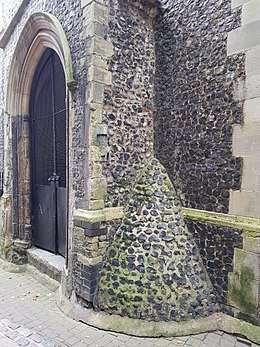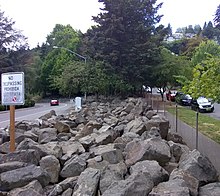Hostile architecture
Hostile architecture is an urban-design strategy that uses elements of the built environment to purposefully guide or restrict behaviour in order to prevent crime and maintain order. It often targets people who use or rely on public space more than others, such as youth and the homeless, by restricting the physical behaviours in which they can engage.[1] Also known as defensive architecture, hostile design, unpleasant design, exclusionary design, and defensive urban design, the term hostile architecture is often associated with "anti-homeless spikes" – studs embedded in flat surfaces to make sleeping on them uncomfortable and impractical.[2][3] Other measures include sloped window sills to stop people sitting; benches with armrests positioned to stop people lying on them, and water sprinklers that "intermittently come on but aren't really watering anything."[4][5] Hostile architecture is also employed to deter skateboarding, littering, loitering, and public urination.
.jpg)
Background

Although the term "hostile architecture" is recent, the use of civil engineering to achieve social engineering is not: antecedents include 19th century "urine deflectors".[6][7] Its modern form is derived from the design philosophy Crime Prevention through Environmental Design (CPTED), which aims to prevent crime or protect property through three strategies: natural surveillance, natural access control, and territorial enforcement.[8]
Critics of hostile architecture argue that it makes contrarianism impossible, that it replaces public spaces with commercial or "pseudo-public" spaces and uses architecture "to enforce social divisions".[9][10] Sociologist Robert Park wrote: "In making the city we make ourselves, one might wonder what collective self-conception has produced a city covered in metal spikes, illuminated by blue lights, buzzing with high-frequencies – paranoid, anxious and hostile, by design."[11] Consistent with the widespread implementation of defensible space guidelines in the 1970s, most implementations of CPTED as of 2004 are based solely upon the theory that the proper design and effective use of the built environment can reduce crime, reduce the fear of crime, and improve the quality of life. Built environment implementations of CPTED seek to dissuade offenders from committing crimes by manipulating the built environment in which those crimes proceed from or occur. The six main concepts according to Moffat are territoriality, surveillance, access control, image/maintenance, activity support and target hardening. Applying all of these strategies is key when trying to prevent crime in any neighborhood, crime ridden or not.[12]

Applications

Camping deterrent
- Seattle city government installed bicycle racks to prevent the homeless from camping.[14][15]
- Since 2013, the State of Oregon Transportation Department in United States deployed large boulders at eight locations that have been experiencing problems with transient camps in Portland. These boulders are a form of hostile architecture and they were installed to deter illegal camping near the freeways.[16]
Skateboarding deterrent
Public reception
Proponents say hostile architecture in urban design is necessary to maintain order and safety and deter unwanted behaviors such as loitering, skateboarding and sleeping. Opponents say they're not needed and target the vulnerable disproportionately.[17]
In 2018, British artist Stuart Semple created a social media public awareness campaign encouraging the public to place identifying stickers on instances of hostile design in their environment.[18][19][20]
Gallery
 "Sitzkiesel" ("sitting-pebble") replacing a former bench in the Kleiner Tiergarten park in Berlin, Germany
"Sitzkiesel" ("sitting-pebble") replacing a former bench in the Kleiner Tiergarten park in Berlin, Germany Spikes added around fountain in Government Center, Miami, in 2011 at downtown transit center
Spikes added around fountain in Government Center, Miami, in 2011 at downtown transit center Ledge with skatestoppers preventing skateboarders from grinding
Ledge with skatestoppers preventing skateboarders from grinding
See also
References
- Chellew, Cara (2019). "Defending Suburbia: Exploring the use of defensive urban design outside of the city centre". Canadian Journal of Urban Research. 28: 19–33.
- Omidi, Maryam (12 June 2014). "Anti-homeless spikes are just the latest in 'defensive urban architecture'". The Guardian. Retrieved 23 February 2015.
- Andreou, Alex (18 February 2015). "Anti-homeless spikes: 'Sleeping rough opened my eyes to the city's barbed cruelty'". The Guardian. Retrieved 23 February 2015.
- Quinn, Ben (13 June 2014). "Anti-homeless spikes are part of a wider phenomenon of 'hostile architecture'". The Guardian. Retrieved 23 February 2015.
- Mills, Chris (21 February 2015). "How 'Defensive Architecture' Is Ruining Our Cities". Gizmodo.com. Retrieved 23 February 2015.
- Swain, Frank (2 December 2013). "Secret city design tricks manipulate your behaviour". BBC.
- Lee, Jackson (23 July 2013). "Urine Deflectors in Fleet Street". The Cat's Meat Shop. Retrieved 23 February 2014.
- Chellew, Cara (2016). "Design Paranoia". Ontario Planning Journal. 31 – via ResearchGate.
- Swain, Frank (5 December 2013). "Designing the Perfect Anti-Object". Medium. Retrieved 23 February 2015.
- Shea, Michael (5 August 2014). "On the frontline: The architectural policing of social boundaries". Discover Society. Retrieved 23 February 2015.
- Living, Mira Adler-Gillies for Blueprint for (2018-03-02). "How 'hostile design' is quietly hurting our cities". ABC News. Retrieved 2019-03-11.
- Wilson, Paul (1989). Designing Out Crime. Australian Institute of Criminology. p. 23.
- Andreou, Alex (2015-02-18). "Defensive architecture: keeping poverty unseen and deflecting our guilt". The Guardian. ISSN 0261-3077. Retrieved 2020-07-25.
- Groover, Heidi (19 December 2017). "Seattle Uses Bike Racks to Discourage Homeless Camping". The Stranger. Retrieved 17 December 2017.
- "New anti-homeless architecture: Seattle uses bike racks to block rough sleepers". the Guardian. 2018-01-24. Retrieved 2020-07-25.
- Kruzman, Diana (2019-07-04). "Portland's homeless campers face new obstacle: piles of boulders". oregonlive. Retrieved 2020-07-25.
The boulders are a form of hostile architecture or defensive design
- Hu, Winnie (2019-11-08). "'Hostile Architecture': How Public Spaces Keep the Public Out". The New York Times. ISSN 0362-4331. Retrieved 2020-07-25.
- Wallace, Elizabeth. "What's Behind the Uptick in Hostile Architecture?". Architectural Digest. Retrieved 2020-07-25.
- "Stuart Semple launches campaign to eradicate 'hostile design' around the world". theartnewspaper.com. Retrieved 2018-02-15.
- "Artist Launches Campaign to Call Out Hostile Urban Design". Hyperallergic. 2018-02-01. Retrieved 2018-02-15.
External links
- Cara Chellew, Bars, barriers and ghost amenities: Defensive urban design in Toronto Torontoist.
- Lloyd Alter, Hostile design doesn't work for any age group Mother Nature Network.
- Cara Chellew, Defensive Inequalities Spacing Magazine.
- "When Design Is Hostile On Purpose". Popsci. Popsci. Retrieved 16 August 2017.
- HostileDesign.org, Project homepage of Stuart Semple sticker campaign.